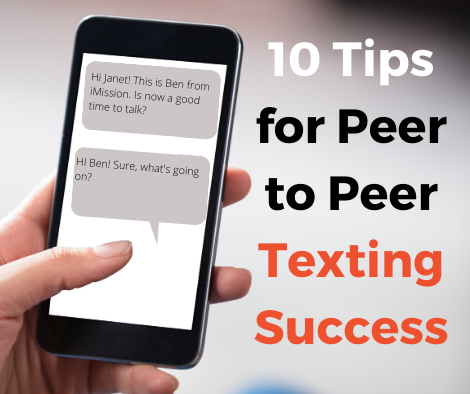Texting is a powerful tool for nonprofit engagement.
For starters, texts are typically 3-4x more likely to be opened and read than an email sent through a platform like Constant Contact or MailChimp. Peer-to-peer (P2P) texting for nonprofits is also much more likely than email to elicit a response from the recipient, starting a personal two-way text conversation.
But here’s the rub: P2P texting does not allow the simultaneous sending of a text to a list of recipients like what is done with email marketing platforms. Instead, a person, like a staff member, board member, or volunteer, must send each individual message to each individual recipient – much like an email you’d send personally from Microsoft Outlook or Gmail. Using a P2P platform allows you to streamline the communication process so your campaign can succeed.
P2P platforms provide a powerful solution to allow you to scale your message.
With a P2P platform, a single sender can text thousands of people per hour. The conversation can start – and start quickly. The data from these conversations can then be imported into your database, like Salesforce, so that the history of the relationship with the recipient can be enriched.
If you’re thinking about using P2P to help support a fundraising drive, build awareness of an event, or promote action around your mission, we’ve put together a list of 10 quick tips to help you start on the right foot.


1. Plan for the campaign:
Role play with your team to get a real-world feel for how your campaign should be structured. Have your team portray potential donors/participants and let them ask whatever natural questions come to mind. Use these questions and answers to help frame your scripting for the campaign.
2. Keep it brief.
Most P2P platforms include a character counter when you’re crafting your pre-scripted messages & replies. Keep the counter in mind as you don’t want to be sending really long messages. Some cell carriers will break longer messages into multiple texts, which can be off-putting to some recipients.
3. Personalize.
Especially in your initial text, be sure to refer to the individual by name, identify the text Sender (your volunteer or team member), and your organization. It’s also a good idea to stay away from jargon. Texting is by its nature very personal, so you don’t want to begin with something generic like, “Dear Friend…”
4. Test your voice/message.
If possible, set up a test of different texts that vary the tone of your message. Consider the overall tone of your organization. Will you include emojis in your text, conveying a more personal, relaxed tone, or will your tone be more authoritative? You can try both!
5. Train your volunteers with a live test run
of small groups. Before your team starts a live campaign to your target audience, have them interact with each other to become comfortable with the screens/scripts. This way you’ll get your team conversant on using the platform, and you may also come up with additional questions/answers to add to your scripted bank of replies.
6. Empower your team.
While it’s important to have a well-considered bank of replies available for your team to use, give your Sender team the ability to compose individual messages. Oftentimes the situation may call for a personalized answer. Give your team the power to handle it properly and use their own good judgement.


7. Stay white hat.
If a recipient asks to be removed, unsubscribed, or opted out of your messaging, be sure your opt-out procedure is ready. Train your team to make a judgement call as to whether or not to send a final opt-out confirmation message to the recipient, and make sure your Sender team knows how the opt-out process works for your platform so they can explain how it works when needed.
8. Get feedback.
At the end of your first live session, meet with your team and debrief them. Were there any sticking points? Were there any surprises? Meet with your team/ Sending volunteers daily and adjust your outbound campaign messages as necessary.
9. Expect phone calls/follow up.
Some people simply prefer to speak directly to a person, as opposed to texting. Be sure your team has a phone number they can offer (or that can be called directly by anyone receiving a text) to further a conversation or answer additional questions.
10. Use the P2P Survey Questions.
Train your team to answer a Survey Question or two while they are interacting with people on the platform. Remember, the Survey Questions are for the Sender to answer about the recipient. Keep this short and simple and related to your goal, i.e. Will this person be attending the fundraiser? yes/no or Was the fundraising link delivered? yes/no. The answers to the Survey Questions are important as this is data that can be downloaded and analyzed. Basic reporting will show you the total number of texts sent and the number of people engaged, but the answers to your Survey Questions will shed a lot more light on the ultimate success of your campaign.
Get Started with Peer to Peer Texting
iMission can help get your organization up and running with a comprehensive P2P campaign. We can help design and create your P2P campaign, train your team, and support your nonprofit’s goal with best-in-class P2P tools. Whether your focus is fundraising, advocacy, or building awareness, iMission can help you succeed.
Give us a call to discuss your campaign! (203) 747-8042 Ext 700 or email us at info@imissioninstitute.org for more information.



